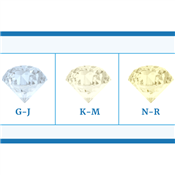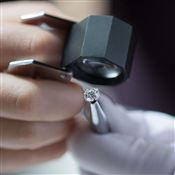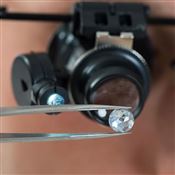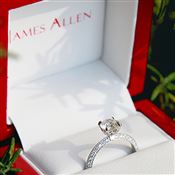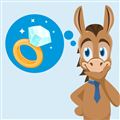Best Diamond Color: Why G, H, and I are Good Value
Picking a diamond's color depends on many factors. Learn why G, H, and I diamonds offer the most value for your money.
Best Diamond Color for the Money
When shopping for a diamond for an engagement ring, a lot of people stress over the color. We're here to clear it up (pun not intended).
Many people assume that a colorless diamond will appear more brilliant, but color really has nothing to do with brilliance (that's cut all the way). But it is still an important factor because it contributes to the overall appearance of the diamond.
This doesn't mean you need to spend more on a high color grade. In fact, this is an area you can save a considerable amount of money. The casual admirer will not be able to see the difference between color grades.
In this guide, we'll talk about what to consider when it comes to color and how to pick the most ideal color for the best value.
Keep reading to learn the smart rules to shop by.
Bottom Line: Depending on where you shop, prices could fluctuate wildly. In order to the get the best value, you should check out online retailers like James Allen.
They are up to 40% cheaper than big box jewelers and their large selection lets you choose the exact cut and color you want. This could mean thousands of dollars in savings.
What is Diamond Color?
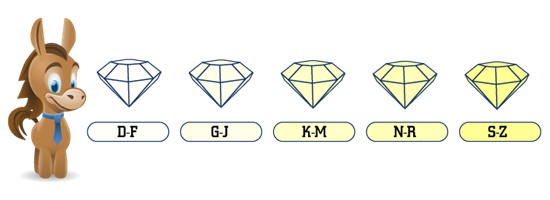 |
| Diamond Color Scale © CreditDonkey |
The color of a diamond refers to how clear a diamond is. Most colorless diamonds have a slight yellow tint because of the presence of nitrogen. True colorless diamonds are extremely rare in nature.
GIA grades color on a sliding scale arranged into 5 groupings:
- D-F (Colorless):
D diamonds are absolutely colorless and extremely rare. E and F are considered colorless (and also super rare) because only an expert gemologist can detect tiny, tiny traces of color. There is no visible difference between these diamonds. - G-J (Near Colorless):
A slight undertone of yellow can be detected by an expert gemologist. G,H, I diamonds are great value because the average person cannot see the yellow. For J diamonds, the color could be a little more noticeable. - K-M (Faint):
A yellow color is more noticeable at this point (i.e., it can be seen without comparing it to a higher color grade diamond). Usually, online retailers don't sell diamonds for engagement rings less than a K. Personally, we think K diamonds look great on yellow gold rings. - N-R (Very Light):
Very noticeable yellow tint and looks like a poor quality diamond even to an untrained eye. - S-Z (Light):
Color at this range can start to have a brown tint. Needless to say, there is very little demand for these.
Before going to a local jeweler, read Blue Nile reviews and James Allen reviews. These reputable online retailers offer high-quality images and videos of their gems so shoppers know what they're getting.
GIA determines color by placing the loose diamond upside down and comparing it against a set of master stones. The diamonds are flipped upside down because color is more obviously seen this way.
Diamond Color Comparisons
Here's how the different color grades look next to each other.
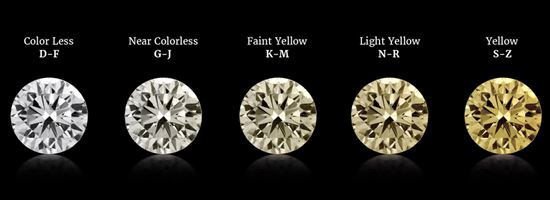 |
When lined up like this, it is easier to see a color difference between colorless and colorless grades.
But in real life, the diamond will be mounted in a ring. People will be admiring the whole ring. They won't be comparing your diamond against another one side-by-side.
And plus, a sparkly diamond will reflect light back. That's why the cut is most important. It can make a diamond so sparkly that it hides color.
Are Colorless Diamonds Worth It?
Colorless diamonds (D, E, F) are priced at a premium because of how rare they are. Near colorless diamonds (G - J) are significantly cheaper.
But the average eye cannot tell the difference. It takes at least 3-4 grade gaps to see color differences when comparing diamonds next to each other. Meaning to the normal person, a D diamond and an H diamond look the same.
So is it worth the extra dough just to have "colorless" on a piece of paper?
This is a very personal choice. Some people (especially in the Asian market) are after perfection, and love knowing they have something so rare. Some people also enjoy the very icy-white look of a D-colored diamond.
But for the average person, an H diamond will also appear perfectly white. Paying extra for that "colorless" stamp is just paying for something that you can't fully appreciate.
Unless your fiancée is going to be comparing her diamond next to her best friend's absolutely colorless one, it's a pretty safe bet that she won't know that her diamond is "near colorless."
Why G-I Diamonds Are Best Value
By choosing a near colorless diamond (G-I), you can save a lot of money while still getting a stone that appears white. Let's take a look at how that works.
Here's an example to give you an idea of the price difference in color grades. We're using a benchmark of 1-carat, VS2 clarity, and Ideal cut.
| Carat | Color | Clarity | Cut | Price* |
|---|---|---|---|---|
| 1.0 | K | VS2 | Ideal | $3,200 |
| 1.0 | J | VS2 | Ideal | $3,700 |
| 1.0 | I | VS2 | Ideal | $4,600 |
| 1.0 | H | VS2 | Ideal | $5,300 |
| 1.0 | G | VS2 | Ideal | $5,600 |
| 1.0 | F | VS2 | Ideal | $6,200 |
| 1.0 | E | VS2 | Ideal | $6,400 |
| 1.0 | D | VS2 | Ideal | $6,700 |
| *Pricing based on typical market price of online diamond retailers as of 2023. | ||||
Wow! The price difference is staggering. A true colorless 1-carat diamond goes for almost $7,000, while going down to an H diamond is $5,300.
A casual observer cannot see the difference. It's clear what the better budget-friendly option is.
Best Diamond Color Based on Ring Setting
There's another thing to consider too: the color of the ring.
The metal color will have a big impact on how white (or yellow) your diamond appears. You probably already know what metal your girl prefers - white gold or platinum, yellow gold, or rose gold. So now, you just need to select a diamond color grade that works best with the metal.
Here's the rule of thumb:
- White gold and platinum rings:
Don't go below I color (H for larger carat stones). A lower color grade will have a more noticeable yellow tint against the silvery-white metal. - Yellow gold and rose gold rings:
You can go down to a J color and the diamond will look white against the ring. If you prefer an overall warmer look, you can even do a K diamond and it'd look gorgeous.You don't need a higher color grade. A diamond will naturally pick up the color of its surroundings. So in a yellow gold band, even the iciest of diamonds will take on a warmer yellow tone. It'd be a waste splurging for a colorless diamond.
Rules to Shop by
To wrap this up, here are the basic guidelines to go by when considering the diamond's color:
- The setting makes the biggest impact.
If you still want to go for a D-F (colorless) diamond, you'd want a platinum or white gold setting. This would be wasted on a yellow band, because the diamond will pick up the color. For white gold or platinum settings, we don't recommend going below I. Yellow gold rings can be paired with a J diamond. - As always, cut is the most important.
Cut is what makes the diamond shine. So never skimp on it! A well-cut diamond lower in color grade will appear more brilliant than a poorly cut, colorless diamond. - The shape of the diamond plays a large role.
Well-cut round diamonds are fiery and brilliant, and do an excellent job of masking color. On the other hand, fancy-cut diamonds with pointed tips (like marquise and pear) can trap color at the points. If you're after one of these cuts, it's best to go up a color grade (to H at the lowest).Step cuts (like emerald and asscher) are known for their depths and luster, rather than their brilliance. So color is more easily revealed. For these cuts, we'd say H for best value (G if it's a large stone).
Tip: Recommended colors are for white gold or platinum bands. Remember, you can afford to go down in color a couple of grades for yellow gold, so adjust accordingly. - Size matters too.
If you're purchasing a bigger rock (2 carats or over), you'd want to go slightly up in color as well, since color in bigger diamonds will be more visibly noticed.For more information on the stone's size, check out our guides for 1 carat, 2 carat and 3 carat diamond engagement rings.
The Bottom Line
Hopefully, you now see why there's no need to go out and purchase the highest color grade you can afford. Near-colorless diamonds in the G-I range will offer the bang for your buck, as the casual observer will not be able to tell the difference.
Take the setting into consideration too, as it'll have the largest impact on how color is perceived. In our opinion, the most important is that you choose a color that matches the setting.
Write to Anna G at feedback@creditdonkey.com. Follow us on Twitter and Facebook for our latest posts.
Note: This website is made possible through financial relationships with some of the products and services mentioned on this site. We may receive compensation if you shop through links in our content. You do not have to use our links, but you help support CreditDonkey if you do.
|
|
| ||||||
|
|
|
